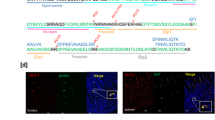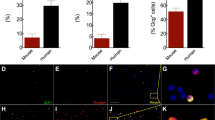Abstract
Studies of various species have demonstrated that the postprandial rise in serum gastrin levels is primarily attributable to the proteinaceous substances ingested1–5. Although it is generally assumed that dietary amino acids are the primary stimulants of gastrin release, evidence supporting this notion based on experiments in vivo has been conflicting and unconvincing6–10. We have investigated the role of amino acids as stimulants of gastrin release using a preparation of isolated rodent gastrin-containing G cells11,12. We report here that the ability of an amino acid to stimulate gastrin release in vitro is directly correlated with its lipid solubility, the aromatic and long chain aliphatic amino acids being the most potent. In addition, we provide evidence that amino acid decarboxylation may be a necessary step in gastrin release as inhibitors of decarboxylase activity abolished amino acid-induced gastrin release, and amines, the decarboxylated derivatives of amino acids, were potent stimulants of hormone secretion in vitro. Thus, the uptake and decarboxylation of amine precursors may be a functionally important property of cells belonging to the APUD (amine precursor uptake and decarboxylation) class of endocrine cells.
This is a preview of subscription content, access via your institution
Access options
Subscribe to this journal
Receive 51 print issues and online access
$199.00 per year
only $3.90 per issue
Buy this article
- Purchase on Springer Link
- Instant access to full article PDF
Prices may be subject to local taxes which are calculated during checkout
Similar content being viewed by others
References
Saint-Hilaire, S., Lavers, M. K., Kennedy, J. & Code, C. F. Gastroenterology 39, 1–11 (1960).
Debas, H. T., Csendes, A., Walsh, J. H. & Grossman, M. I. in Endocrinology of the Gut (eds Chey, W. Y. & Brooks, S. P.) 222–232 (Charles B. Slack, New Jersey, 1974).
Debas, H. T., Walsh, J. H. & Grossman, M. I. in Gastrointestinal Hormones (ed. Thompson, J. C.) 425–435 (University of Texas Press, Texas 1975).
Richardson, C. T., Walsh, J. H., Hicks, J. I. & Fordtran, J. S. J. clin. Invest. 58, 623–631 (1976).
Walsh, J. H. Fedn. Proc. 36, 1948–1951 (1976).
Walsh, J. H. & Grossman, M. I. N. Engl. J. Med. 292, 1377–1384 (1975).
Elwin, C. E. & Uvnas, B. in Gastrin (ed. Grossman, M. I.) 69–82 (UCLA Press, Los Angeles 1966).
Elwin, C. E. Scand. J. Gastroent. 9, 239–247 (1974).
Konturek, S. J., Tasler, J., Cieszkowski, M., Dobrzanska, M. & Wunsch, E. Am. J. Physiol. 233, 170–174 (1977).
Strunz, U. T., Walsh, J. H. & Grossman, M. I. Proc. Soc. exp. Biol. Med. 157, 440–441 (1978).
Forssmann, W. G., Lichtenberger, L. M., Helmstaedter, V. & Ito, S. Cell Tissue Res. 200, 163–177 (1979).
Lichtenberger, L. M., Forssmann, W. G. & Ito, S. Gastroenterology 79, 447–459 (1980).
Schanker, L. S. J. Mednl pharm. Chem. 2, 343–359 (1960).
Pearse, A. G. E. J. Histochem. Cytochem. 17, 303–313 (1969).
Holtz, P. & Palm, D. Pharmac. Rev. 16, 113–178 (1964).
Lovenberg, W., Weisback, H. & Udenfriend, S. J. biol. Chem. 237, 89–93 (1962).
Kobayashi, S. Archs Histol. Jap. 37, 313 (1975).
Rubin, W. & Schwartz, B. Gastroenterology 81, 311–320 (1981).
Yalow, R. S. & Berson, S. A. Gastroenterology 58, 1–14 (1970).
Stadil, F. W. & Rehfeld, J. F. Scand. J. clin. Invest. 30, 361–368 (1972).
Dockray, G. J. & Walsh, J. H. Gastroenterology 68, 222–230 (1975).
Bigelow, C. C. & Channon, M. in Handbook of Biochemistry and Molecular Biology 3rd edn (ed. Fasmann, G. D.) 209 (CRC, Ohio 1976).
Stadil, F. & Rehfeld, J. F. Gastroenterology 66, 7–15 (1974).
Hayes, J. R., Ardill, J., Kennedy, L., Buchanan, K. D. & Shanks, R. G. Lancet i, 819–821 (1972).
Lichtenberger, L. M., Szabo, S. & Trier, J. S. Gastorenterology 73, 1305–1308 (1977).
Author information
Authors and Affiliations
Rights and permissions
About this article
Cite this article
Lichtenberger, L., Delansorne, R. & Graziani, L. Importance of amino acid uptake and decarboxylation in gastrin release from isolated G cells. Nature 295, 698–700 (1982). https://doi.org/10.1038/295698a0
Received:
Accepted:
Issue Date:
DOI: https://doi.org/10.1038/295698a0
This article is cited by
-
How Helicobacter pylori infection controls gastric acid secretion
Journal of Gastroenterology (2012)
-
Chronic Hypergastrinemia: Causes and Consequences
Digestive Diseases and Sciences (2007)
-
Effects of hypochlorhydria and hypergastrinemia on structure and function of gastrointestinal cells
Digestive Diseases and Sciences (1995)
-
Accumulation of aliphatic amines in gastric juice of acute renal failure patients
Digestive Diseases and Sciences (1993)
Comments
By submitting a comment you agree to abide by our Terms and Community Guidelines. If you find something abusive or that does not comply with our terms or guidelines please flag it as inappropriate.



